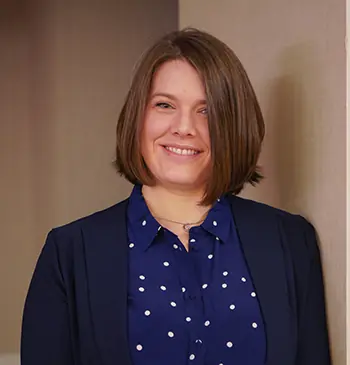Laura Alix is the Director of Research at Bank Director, where she collaborates on strategic research for bank directors and senior executives, including Bank Director’s annual surveys. She also writes for BankDirector.com and edits online video content. Laura is particularly interested in workforce management and retention strategies, environmental, social and governance issues, and fraud. She has previously covered national and regional banks for American Banker and community banks and credit unions for Banker & Tradesman. Based in Boston, she has a bachelor’s degree from the University of Connecticut and a master’s degree from CUNY Brooklyn College.

Two CEOs Discuss How Their Banks Cultivate C-Suite Talent
The heads of b1Bank and Lake City Bank share their perspectives on hiring outside the industry, evolving skills at the top and connecting the board with senior leadership.
Every bank needs the right people to grow and move its strategy forward, particularly in the C-suite. But planning for those roles is often a challenge. Most executive leadership positions require specialized expertise that’s tough to find in other industries. And the skills that senior leaders need can change as a bank grows larger and faces more regulatory scrutiny.
David Findlay, CEO of $6.9 billion-Lakeland Financial Corp. in Warsaw, Indiana, and Jude Melville, CEO of the $7.9 billion Business First Bancshares in Baton Rouge, Louisiana, recently talked with Laura Alix, director of research at Bank Director, about how they approach these dynamics. Both banks share a strong focus on talent and leadership, running internal training programs and offering rotational work to high-potential bankers.
The transcript below has been edited for brevity, clarity and flow. To watch the full conversation, inspired by Bank Director’s 2025 Compensation & Talent Survey, access the webinar recording here.
BD: Most of our survey respondents say their bank hasn’t filled a senior role with talent sourced outside of the industry. What are your experiences and thoughts on this?
Melville: I’m absolutely open to the idea of bringing folks in from outside the industry. I do think that there are certain roles that are easier to bring in somebody from the outside than others. Obviously it’s difficult to bring in somebody to be your chief credit officer who’s never been around a bank. But I think for roles like marketing, for example, it actually would be pretty exciting to have somebody from outside with a fresh pair of eyes.
As we figure out how to take on some of the technological challenges and opportunities that we’ll have in the next decade, I think it’ll be more and more relevant to bring in people from the outside. We don’t have as much internal talent on that front as you might think, and the world’s quickly changing, so we’ll have to change with it.
Findlay: When I think about the external hiring over the last several years for roles like our chief technology officer, we’ve benefited tremendously from bringing in a set of eyes that does not come from inside the organization but comes from the industry, with ideas and innovations that are different from what we’ve been doing.
BD: How do the skills or qualities needed in the C-suite change as a bank grows, particularly from $1 billion to $10 billion in assets?
Findlay: When we hit the $5 billion mark, we said that we need to make sure when we get to $10 billion, that we were already managing ourselves like a $10 billion bank. So, the challenges that come with crossing that threshold have already been addressed. The staff has been added, the resources have been allocated, the technology has been invested in. When we look at our executive leadership team, do the people in that room have the ability to understand what the evolution of the business will be if you get larger? When can you look at your control environment, the policies and procedures, and know that those have matured along with the balance sheet?
Melville: There are skills that I think need to be learned as you get bigger. One is managing through data.
When we all are getting started — whether that be as a commercial banker who has an individual portfolio or in our case a de novo bank — you have a limited number of clients and a limited number of employees. It’s about people and specific relationships.
The next step is managing through processes. The only way to make sure you’re doing that correctly is to be comfortable with data. A lot of being over $10 billion is being able to share with your regulators, “This is the data from our bank.” If it’s not in the data, then it’s not real. The good news is that preparing to do that makes you better internally, because you need to do it whether they want to see it or not.
You don’t want to lose the relationships, but there’s a balance between the two. That’s one skillset that I think leaders have to learn over time as your organization gets bigger.
BD: How do you help new directors understand the dynamics of your C-suite?
Findlay: We have our entire management committee, all nine of them, sit in every board meeting and on committee meetings. We’ve got multiple staff in those, as well. It’s important for the directors to have that interaction with the key leaders within the bank. By exposing the directors to not only the management committee but other people deeper into the organization, that’s the best way you could possibly give them the confidence that they have the right people in the right positions.
Melville: It really takes time and exposure. When I’m serving on other boards, there’s no way that I can know that company or that organization as well as the leadership does.
My job as a board member is to make sure that I feel comfortable that we have the right people in place, and if we have the right people in place, then things are going to work out. The more I can make the board feel comfortable through exposure to those people, that they are the right people, then the better board members should feel about the organization.


